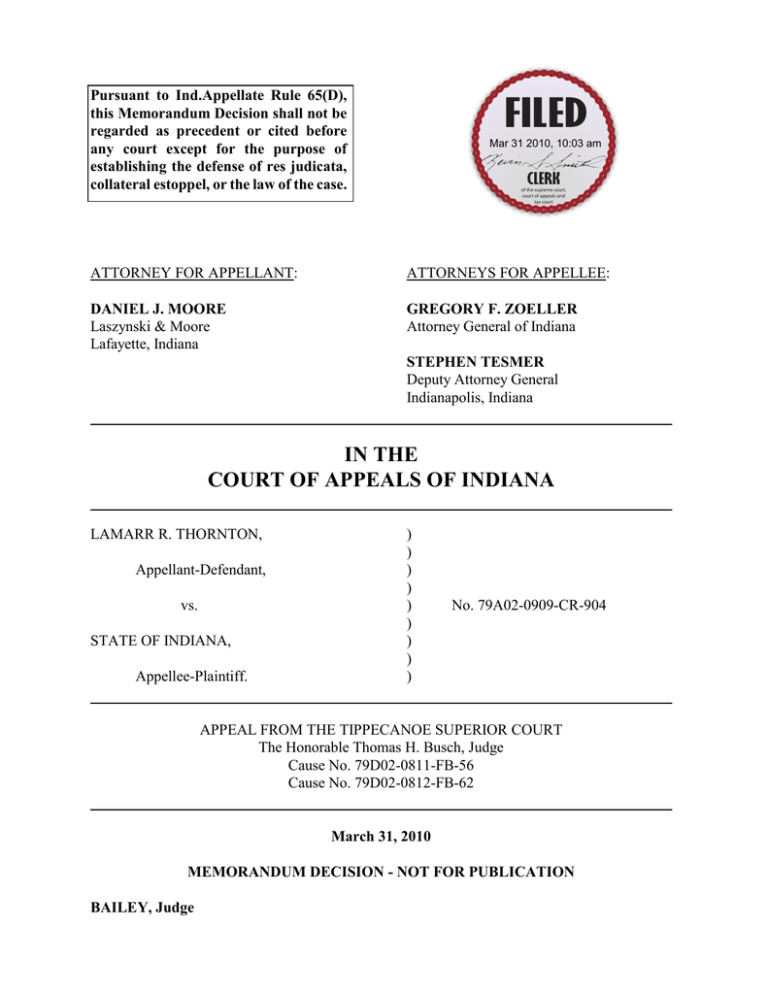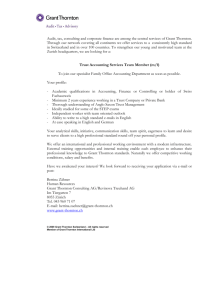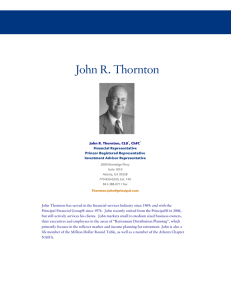Lamarr R. Thornton v. State of Indiana
advertisement

FILED Pursuant to Ind.Appellate Rule 65(D), this Memorandum Decision shall not be regarded as precedent or cited before any court except for the purpose of establishing the defense of res judicata, collateral estoppel, or the law of the case. Mar 31 2010, 10:03 am CLERK of the supreme court, court of appeals and tax court ATTORNEY FOR APPELLANT: ATTORNEYS FOR APPELLEE: DANIEL J. MOORE Laszynski & Moore Lafayette, Indiana GREGORY F. ZOELLER Attorney General of Indiana STEPHEN TESMER Deputy Attorney General Indianapolis, Indiana IN THE COURT OF APPEALS OF INDIANA LAMARR R. THORNTON, Appellant-Defendant, vs. STATE OF INDIANA, Appellee-Plaintiff. ) ) ) ) ) ) ) ) ) No. 79A02-0909-CR-904 APPEAL FROM THE TIPPECANOE SUPERIOR COURT The Honorable Thomas H. Busch, Judge Cause No. 79D02-0811-FB-56 Cause No. 79D02-0812-FB-62 March 31, 2010 MEMORANDUM DECISION - NOT FOR PUBLICATION BAILEY, Judge Case Summary Lamarr R. Thornton (“Thornton”) challenges the aggregate twenty-four-year sentence imposed following his plea of guilty to two counts of Burglary, as Class B felonies,1 and four counts of Theft, as Class D felonies.2 We revise the aggregate sentence to twenty years. Issues Thornton presents two issues for review: I. Whether the trial court abused its sentencing discretion by considering dismissed charges as aggravators; and II. Whether his sentence is inappropriate. Facts and Procedural History On November 12, 2008, under cause number 79D02-0811-FB-56, Thornton was charged with one count of Burglary and five counts of Theft. On December 9, 2008, under cause number 79D02-0812-FB-62, Thornton was charged with one count of Burglary and ten counts of Theft. Thornton and the State entered into a plea agreement, whereby Thornton would plead guilty to the Burglary charges and four counts of Theft. The parties agreed that, consistent with Indiana Code Section 35-50-1-2(d)(B), the sentences imposed for the Burglary counts were to be served consecutively, as Thornton had committed one burglary while released on bond for the other. The theft sentences were to be served concurrently. The trial court accepted Thornton’s guilty plea, conducted a sentencing hearing, and imposed an aggregate sentence of twenty-four years (consecutive twelve-year sentences for 1 2 Ind. Code § 35-43-2-1. Ind. Code § 35-43-4-2. 2 each of the Burglary counts, with two-year concurrent sentences for each of the Theft convictions). Eight years were suspended to probation, and two years of the executed time were to be spent in a community corrections program. Thornton appealed. Discussion and Decision I. Abuse of Discretion Sentencing decisions are within the sound discretion of the trial court. Anglemyer v. State, 868 N.E.2d 482, 490 (Ind. 2007), clarified on reh’g, 875 N.E.2d 218 (Ind. 2007). However, a trial court may be found to have abused its sentencing discretion if the court (1) failed to enter a sentencing statement at all; (2) entered a sentencing statement that explains reasons for imposing a sentence where the record does not support the reasons; (3) entered a sentencing statement that omits reasons that are clearly supported by the record and advanced for consideration; or (4) entered a sentencing statement in which the reasons given are improper as a matter of law. Id. at 490-91. An abuse of discretion occurs where the trial court’s decision is clearly against the logic and effect of the facts and circumstances before the court, or the reasonable, probable, and actual deductions to be drawn therefrom. Id. at 491. Thornton argues that the trial court abused its discretion when it relied upon the dismissed charges to increase the sentence for the remaining charges. If a trial court accepts a plea agreement whereby the State agrees to drop or refrain from filing charges, and then uses facts that give rise to those charges to enhance a sentence, it effectively circumvents the plea agreement and is therefore improper. See Farmer v. State, 772 N.E.2d 1025, 1027 (Ind. 3 Ct. App. 2002). Here, the prosecutor repeatedly urged the trial court to do just that, reminding the trial court that Thornton had been charged with “seventeen counts” and referencing “seventeen burglaries.” (Tr. 30.) Advising the trial court that there were “seventeen different times having all this stolen property,” the prosecutor added, “with all that in mind, Your Honor, I’m only asking for a slightly aggravated sentence.” (Tr. 31.) The trial court gave the sentence requested by the State. The sentencing order stated as aggravating factors: “the defendant has recently violated the condition of probation, parole, pardon, community corrections or pre-trial release. The seriousness of crime, multiple crimes. The benefit of reduced charges, eleven counts dismissed.” (App. 44.) (emphasis added.) The trial court orally stated that it found as an aggravator “the fact that there were so many crimes,” (Tr. 42), and further observed: The defendant did plead guilty and take responsibility. And while he did get the benefit of reduced charges there are not so many and not so much reduced that [it] substantially diminishes that mitigating factor. (Tr. 43.) This appears to be the trial court’s acknowledgement that Thornton pled guilty to both of the most serious charges against him and this decision was a proper mitigator. The sentencing transcript reveals the prosecutor’s repeated efforts to improperly focus the trial court upon the dismissed charges. In turn, the trial court’s sentencing order and oral statements could collectively be read to suggest that the trial court chose to impose a sentence greater than the advisory sentence for a Class B felony because of the multiple dismissed charges. This constitutes an abuse of discretion. 4 However, even when we conclude that the trial court abused its discretion in finding aggravating circumstances, we need not necessarily reverse the sentence. Roney v. State, 872 N.E.2d 192, 198 (Ind. Ct. App. 2007), trans. denied. We may remand for clarification or a new sentencing determination, affirm the sentence if the error is harmless, or exercise our independent review pursuant to Indiana Appellate Rule 7(B). See id.; Hollin v. State, 877 N.E.2d 462, 465 (Ind. 2007). We cannot confidently say that the trial court would have imposed the same sentence absent consideration of the improper aggravator. Accordingly, we do not find harmless error, but will proceed to independent review. II. Inappropriateness In Reid v. State, the Indiana Supreme Court reiterated the standard by which our state appellate courts independently review criminal sentences: Although a trial court may have acted within its lawful discretion in determining a sentence, Article VII, Sections 4 and 6 of the Indiana Constitution authorize independent appellate review and revision of a sentence through Indiana Appellate Rule 7(B), which provides that a court may revise a sentence authorized by statute if, after due consideration of the trial court’s decision, the Court finds that the sentence is inappropriate in light of the nature of the offense and the character of the offender. The burden is on the defendant to persuade us that his sentence is inappropriate. 876 N.E.2d 1114, 1116 (Ind. 2007) (internal quotation and citations omitted). More recently, the Court reiterated that “sentencing is principally a discretionary function in which the trial court’s judgment should receive considerable deference.” Cardwell v. State, 895 N.E.2d 1219, 1222 (Ind. 2008). Indiana’s flexible sentencing scheme allows trial courts to tailor an appropriate sentence to the circumstances presented. See id. at 5 1224. One purpose of appellate review is to attempt to “leaven the outliers.” Id. at 1225. “[W]hether we regard a sentence as appropriate at the end of the day turns on our sense of the culpability of the defendant, the severity of the crime, the damage done to others, and myriad other factors that come to light in a given case.” Id. at 1224. A person who commits a Class B felony has a sentencing range of between six and twenty years, with the advisory sentence being ten years. Ind. Code § 35-50-2-5. As such, Thornton received a sentence two years above the advisory for each of his Class B felony convictions. The nature of the offenses is that Thornton entered apartments and took various items of property for his financial gain. The character of the offender is that Thornton lacked a prior criminal history. However, he was released on bond for one of the instant offenses when he committed another. He decided to plead guilty to the most serious of the charges against him. We conclude that, in light of the nature of the offenses and the character of the offender, advisory sentences of ten years are appropriate for each of Thornton’s burglary convictions. However, because one burglary was committed while Thornton was released on bond for the other, the sentences must be served consecutively pursuant to Indiana Code Section 35-50-1-2(d)(B).3 Thornton’s aggregate sentence, as revised, is twenty years, with two years to be served in community corrections, and eight years suspended to probation. MAY, J., and BARNES, J., concur. 3 The theft sentences, the length of which Thornton has not specifically challenged, remain concurrent. 6

